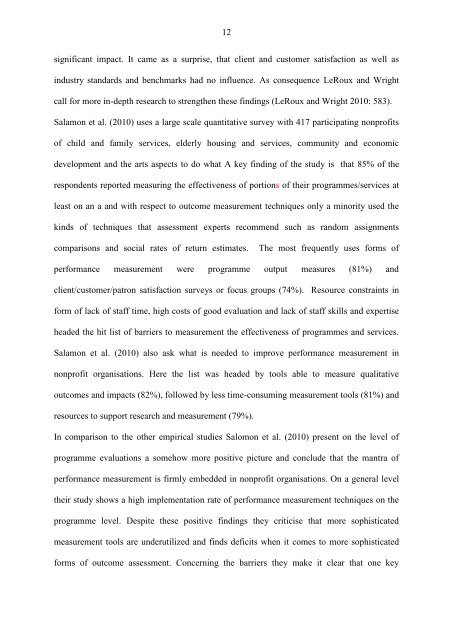Strategic responses to Performance Measurement in Nonprofit ...
Strategic responses to Performance Measurement in Nonprofit ...
Strategic responses to Performance Measurement in Nonprofit ...
You also want an ePaper? Increase the reach of your titles
YUMPU automatically turns print PDFs into web optimized ePapers that Google loves.
12<br />
significant impact. It came as a surprise, that client and cus<strong>to</strong>mer satisfaction as well as<br />
<strong>in</strong>dustry standards and benchmarks had no <strong>in</strong>fluence. As consequence LeRoux and Wright<br />
call for more <strong>in</strong>-depth research <strong>to</strong> strengthen these f<strong>in</strong>d<strong>in</strong>gs (LeRoux and Wright 2010: 583).<br />
Salamon et al. (2010) uses a large scale quantitative survey with 417 participat<strong>in</strong>g nonprofits<br />
of child and family services, elderly hous<strong>in</strong>g and services, community and economic<br />
development and the arts aspects <strong>to</strong> do what A key f<strong>in</strong>d<strong>in</strong>g of the study is that 85% of the<br />
respondents reported measur<strong>in</strong>g the effectiveness of portions of their programmes/services at<br />
least on an a and with respect <strong>to</strong> outcome measurement techniques only a m<strong>in</strong>ority used the<br />
k<strong>in</strong>ds of techniques that assessment experts recommend such as random assignments<br />
comparisons and social rates of return estimates. The most frequently uses forms of<br />
performance measurement were programme output measures (81%) and<br />
client/cus<strong>to</strong>mer/patron satisfaction surveys or focus groups (74%). Resource constra<strong>in</strong>ts <strong>in</strong><br />
form of lack of staff time, high costs of good evaluation and lack of staff skills and expertise<br />
headed the hit list of barriers <strong>to</strong> measurement the effectiveness of programmes and services.<br />
Salamon et al. (2010) also ask what is needed <strong>to</strong> improve performance measurement <strong>in</strong><br />
nonprofit organisations. Here the list was headed by <strong>to</strong>ols able <strong>to</strong> measure qualitative<br />
outcomes and impacts (82%), followed by less time-consum<strong>in</strong>g measurement <strong>to</strong>ols (81%) and<br />
resources <strong>to</strong> support research and measurement (79%).<br />
In comparison <strong>to</strong> the other empirical studies Salomon et al. (2010) present on the level of<br />
programme evaluations a somehow more positive picture and conclude that the mantra of<br />
performance measurement is firmly embedded <strong>in</strong> nonprofit organisations. On a general level<br />
their study shows a high implementation rate of performance measurement techniques on the<br />
programme level. Despite these positive f<strong>in</strong>d<strong>in</strong>gs they criticise that more sophisticated<br />
measurement <strong>to</strong>ols are underutilized and f<strong>in</strong>ds deficits when it comes <strong>to</strong> more sophisticated<br />
forms of outcome assessment. Concern<strong>in</strong>g the barriers they make it clear that one key
















